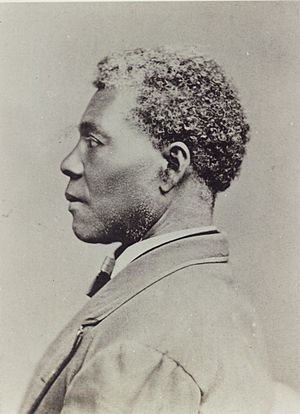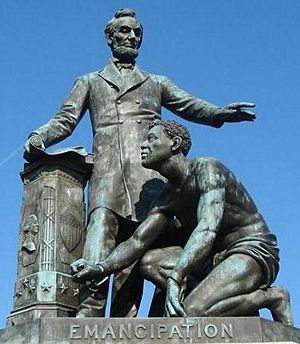Archer Alexander facts for kids
Quick facts for kids
Archer Alexander
|
|
|---|---|
 |
|
| Born | c. 1810-1815 Richmond, Virginia |
| Died | December 8, 1879 (aged 63-69) Saint Louis, Missouri |
| Occupation | Model |
Archer Alexander (born around 1810 or 1815, died December 8, 1879) was an important person in American history. He was once enslaved, but he became free. He is famous for being the model for the freed slave in a statue called the Emancipation Memorial. This statue is in Lincoln Park in Washington, D.C. A book about his life, The Story of Archer Alexander, was written in 1885 by William Greenleaf Eliot.
Contents
Archer Alexander's Early Life
Archer Alexander was born near Richmond, Virginia, around 1810. He was born into slavery. According to William Greenleaf Eliot, he was born around 1815. This happened on a large farm, called a plantation, belonging to the Delaney Ferrell family in Fincastle, Virginia.
When Archer was a child, his father was sold by Ferrell to pay off debts. Soon after, Delaney Ferrell died. Archer Alexander was then given to Delaney's son, Tom Ferrell. In 1831, Tom Ferrell moved to Missouri, taking Archer with him. Archer's mother stayed in Virginia and died a few months later.
In Missouri, Archer Alexander was rented out to work at brickyards in St. Louis. When Tom Ferrell needed more money, he sold Archer to a farmer named Richard H. Pitman. Pitman lived near the border of St. Charles County and Warren County.
Archer Alexander married an enslaved woman named Louisa. She was owned by James Naylor. Louisa was able to move with Archer. Archer worked for Hickman for over twenty years, starting in 1844. Naylor respected Archer enough to let him help manage the farm. Archer and Louisa Alexander had several children during this time.
Archer Alexander During the Civil War
Before the American Civil War began, Archer Alexander paid close attention to the political discussions. He decided he would try to escape slavery if he got the chance.
In 1861, Archer secretly told some Union soldiers that a bridge they planned to use had been damaged on purpose by people who supported the Confederate side. Soon after, people suspected he was the one who gave this information. He had to run away from the farm.
He was caught by people who hunted down escaped slaves. But he managed to break free again. He returned to St. Louis, where he found work. The Federal provost-marshal, a military police officer, protected him.
Archer went to a public market in St. Louis to look for work. William Greenleaf Eliot's wife was also there, looking to hire someone. She hired Archer Alexander and brought him home. Archer didn't talk much about his recent past. This made Eliot suspect that Archer was an escaped slave. Eliot had promised he would never send an escaped slave back to their former owner. Now, he faced this exact situation.
Eliot got a special paper that allowed him to keep Archer for thirty days. He quickly wrote to Hickman, offering to buy Archer. Hickman refused, saying he would get Archer back. Two days before the paper expired, slave catchers hired by Hickman found Archer. Eliot managed to find Archer and keep him safe until the Emancipation Proclamation was issued. This important document declared many enslaved people free.
Archer and his wife, Louisa, were reunited for a short time. In 1866, Louisa decided to go back to Naylor's house to get some things she had left there. Archer later found out that Louisa had died two days after she arrived, from an unknown illness.
The Emancipation Memorial Statue

In 1869, William Greenleaf Eliot was part of a group working to build a statue of Abraham Lincoln. The money for an Emancipation Memorial began with a $5 donation from a former enslaved woman named Charlotte Scott from Virginia. All the first donations came from former enslaved people. Later, The Western Sanitary Commission, a group in St. Louis that helped during the war, matched these donations.
The sculptor, Thomas Ball, made a good model for the statue. But Eliot's group wanted a real freed person to pose for it. Eliot gave Ball a photo of Archer Alexander, and Archer was chosen to be the model for the freed slave in the statue.
In 1876, the statue was officially revealed. Many important people were there, including President Ulysses S. Grant, members of his government, Supreme Court justices, and Frederick Douglass, who was also a former enslaved person. However, neither Archer Alexander nor William Greenleaf Eliot was present at the unveiling.
Archer Alexander's Later Life and Legacy
Archer Alexander died in St. Louis, Missouri, on December 8, 1879. William Greenleaf Eliot and his son, Christopher, were with Archer. Archer gave Christopher a gold watch because Christopher had taught him how to read. Eliot wrote that Archer died thanking God that he had lived and died as a free man.
Through DNA research, it was discovered that the famous boxer Muhammad Ali was a descendant of Archer Alexander.
See Also

